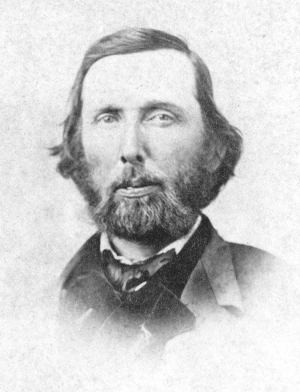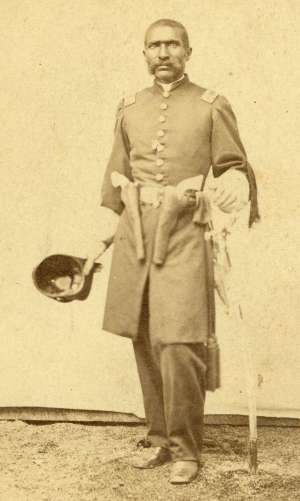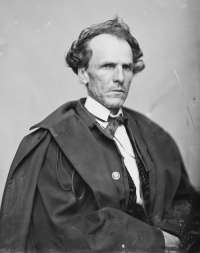From previous marker, continue eEast on 51st, right turn on Wornall Road and turn at first right into Loose Park. This marker is located in the northern end of the semi-circle parking lot.
Union Artillery Historical Marker
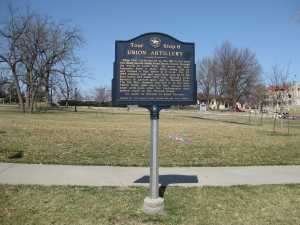
Union Artillery Historical Marker Inscription
"When General Curtis moved up the hill to the west, General Blunt moved south from Brush Creek through the woods to Loose Park. He drove the Confederates from a stone fence along 51st Street and formed a line there at 11:00 A.M., October 23, 1864. Running east and west from Oak Street to the Bent House and south 5000 yards. McLain's Colorado Battery of Parrott guns was in Wornall Lane. The 9th Wisconsin Battery was 100 feet to the west. Thirty Union guns were in line. Attacks were made until noon when the Confederates were pushed south to he Wornall House."
During the early morning’s fighting, Captain William D. McLain’s Independent Battery, Colorado Light Artillery was deployed astride Wornall Lane at this location. McLain’s Battery was assigned to the Fourth Brigade in Blunt’s Provisional Cavalry Division, Col. James H. Ford commanding. Colonel Ford reported the battery having “five 3-inch rifled guns [probably 10-pounder Parrotts], and one mountain howitzer.” Captain Richard J. Hinton, Company B, Second Kansas Colored Infantry Regiment, later wrote about the battery’s deployment.
McLain was in position at the edge of the timber, half a mile to the rear. At first the firing was entirely artillery, with the exception of a few shots exchanged by the skirmish line. The rebels continued deploying, receiving large reinforcements, and advancing with spirit and vigor. Their long lines pressed forward steadily, displaying as they did so in the center a fine battle flag. Two guns, under Lieutenant [George S.] Eayre, were ordered forward, taking position on the hill and overlooking the open prairie across which the enemy was advancing. The guns did excellent work, were double shotted with canister, while the range being short and the firing rapid, every shot told. The enemy's guns replied with vigor.
Confederate General M. Jeff Thompson later wrote how effective the opening artillery fire from McLain’s Battery was.
We were unmolested until we were near the town when the enemy's artillery opened upon us. One of the first shots knocked off the head of a man in Slayback's Battalion, as smooth as a guillotine could have cut it.
Colonel Ford described an attempt by the enemy to neutralize McLain’s Battery.
I formed a portion of the Second Colorado and Sixteenth Kansas on the hill immediately south of Brush Creek, with one section of the battery, but soon after advanced to the edge of the prairie and took up position across the road to the left of Colonel [Charles R.] Jennison's brigade, the section of the battery being placed in the road. For a while the firing was exclusively artillery, but the rebels advancing, the whole line was soon engaged and kept up a very steady and galling fire for two hours or more. The enemy was repeatedly repulsed, and one very bold and dashing charge made by him down the road upon the battery was very handsomely repulsed by portions of the Sixteenth Kansas Cavalry and Second Colorado Cavalry, the countercharge being led in person by Lieutenant-Colonel [Samuel] Walker, commanding Sixteenth Kansas Cavalry, and in which charge he received a very severe wound in the foot.
It was shortly after this when Maj. Gen. James G. Blunt ordered his forces to withdraw down the hill to Brush Creek, McLain’s Battery crossed to the north side of Brush Creek and deployed on high ground north of the creek. But the battery would move up Wornall Lane and onto Bent’s Farm again when the Federals advanced later that morning.
Deployed just west of this location during the late morning was one unit deserving special mention. It was one section from the Independent Battery, U. S. Colored Light Artillery, also known as Douglas’s Battery. Douglas’s Battery was the only Federal unit serving under the command of black officers. The section deployed near here contained two 10-pounder Parrott Guns manned by 30 colored men under the command of Second Lieutenant Patrick H. Minor. The section was attached to the Ninth Wisconsin Light Battery, Captain James H. Dodge commanding, in Colonel Blair’s Third Brigade.
The Independent Battery, U. S. Colored Light Artillery, originated on June 29, 1864 when Maj. Gen. Samuel R. Curtis requested permission from Secretary of War Edwin Stanton to raise a “colored battery.” The next day, Stanton authorized Curtis to raise the battery, and two days later Curtis sent a formal request to Kansas Governor Thomas Carney asking him to raise a colored battery. That same day, Curtis issued General Orders, No. 34.
Major R[obert] H. Hunt, Fifteenth Kansas Volunteer Cavalry, is announced as chief of artillery department, and the recruiting, organizing, and drilling a battery of persons of African descent will be under his supervision.
Two men were instrumental in recruiting volunteers to serve on the colored battery. William D. Matthews was born a free man in Maryland in 1827, moving to Leavenworth, Kansas in 1856. Patrick H. Minor was born in Louisiana in 1829, the son of a white planter, moving to Kansas in 1862. Both men served in the First Kansas Colored Infantry Regiment raised by Kansas Senator James H. Lane. Major Hunt put Matthews and Minor to work recruiting volunteers for the battery. The battery was only partially organized when Lieutenant Minor received orders in mid-October from Major Hunt to pull together one section to assist in resisting Price’s invasion force. Major Hunt wrote about some of the action performed by Lieutenant Minor during the Battle of Westport.
October 23, McLain's battery made some excellent shots, one of which struck one of the enemy's guns near the left trunnion, breaking it in two. Another gun was struck and broken across the chassis by a rifled piece manned by the colored battery, but which was sighted by Captain Dodge, commanding Ninth Wisconsin Volunteer Battery. Both captains used their artillery with skill.
Col. James H. Ford
Maj. Robert H. Hunt
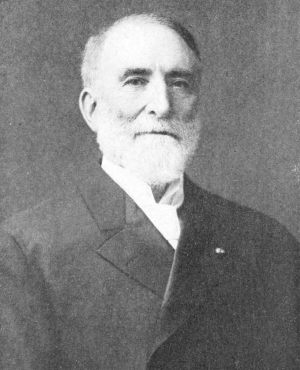
Lt. William D. Matthews
Senator James H. Lane
